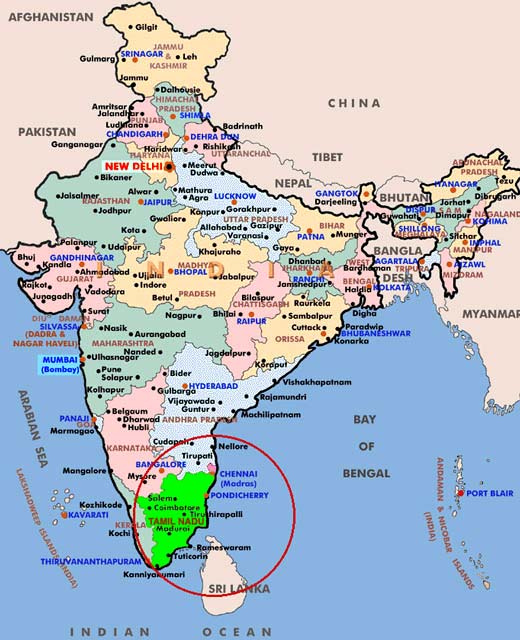
After we left Mahabalipuram, we headed back to Bangalore (in the pink state of Karnataka) via the Puducherry highway (still on the coast) so that we could stop at another temple, one that as Darshan said, “You just can’t miss.” This was a great chance for me to see the state of Tamil Nadu. As you can see from the photo above, Tamil Nadu is in south eastern India.
According to Pallavas history, the Pallavas held supremacy from about the second quarter of the fourth century A.D. Before that, the southern states of India were under the leadership of the Cholas, the Cheras and the Pandyas for centuries. They were the originators of the famous Dravidian style of temple architecture. The last Pallava ruler was Aparajita, in whose reign the later Cholas under Vijayalaya and Aditya asserted themselves by about the 10th century. At the end of the 11th century, Tamil Nadu was ruled by several dynasties like the Chalukyas, Cholas and Pandyas. In the two centuries that followed, the imperial Cholas gained ultimate control over South India.
Muslims gradually strengthened their position, which led to the establishment of the Bahamani Sultanate, by the middle of the 14th century. At the same time, the Vijayanagar Kingdom quickly consolidated itself and extended its sway over the whole of South India, and at the close of the century, Vijayanagar became the supreme power in South. However, it crumbled at the battle of Talikota in 1564 to the confederate forces of the Deccan Sultans.
Even during the period of the tumultuous confusion that followed the battle of Talikota, European commercial interest had appeared as rivals in the area of South India. The Portuguese, the Dutch, the French and the English came in quick succession and established trading centers known as ‘Factories’. East India Company, which had established its factory at Masulipatnam (now in Andhra Pradesh) in 1611, gradually annexed territories by encouraging enmity among the native rulers. Tamil Nadu was one of the first of British settlements in India. The State is the successor to the old Madras Presidency (Chennai back before British was called Madras), which covered the bulk of the southern peninsula in 1901. The composite Madras State was later reorganized, and the present Tamil Nadu was formed.
Tamil Nadu is bounded on north by Andhra Pradesh and Karnataka (where Bangalore is), on the west by Kerala (home of Ayurveda), on the east by the Bay of Bengal, and on the south by the Indian Ocean.

As I was starving, Darshan had taken a break while I was being guided through the Mahabalipuram and had eaten, and in lieu of finding a restaurant that was safe, we stopped off for fresh coconut water. The owner of this roadside coconut farm hacked open the coconut, had me drink the water, then cut up the fruit and gave me the coconut meat to eat. I know that this should not be a “pitta” reaction, but I don’t really care for coconut water and eating the slimy, young coconut meat reminded me of eating oysters. I thanked them as I knew my body would like it–my mind, not so much!
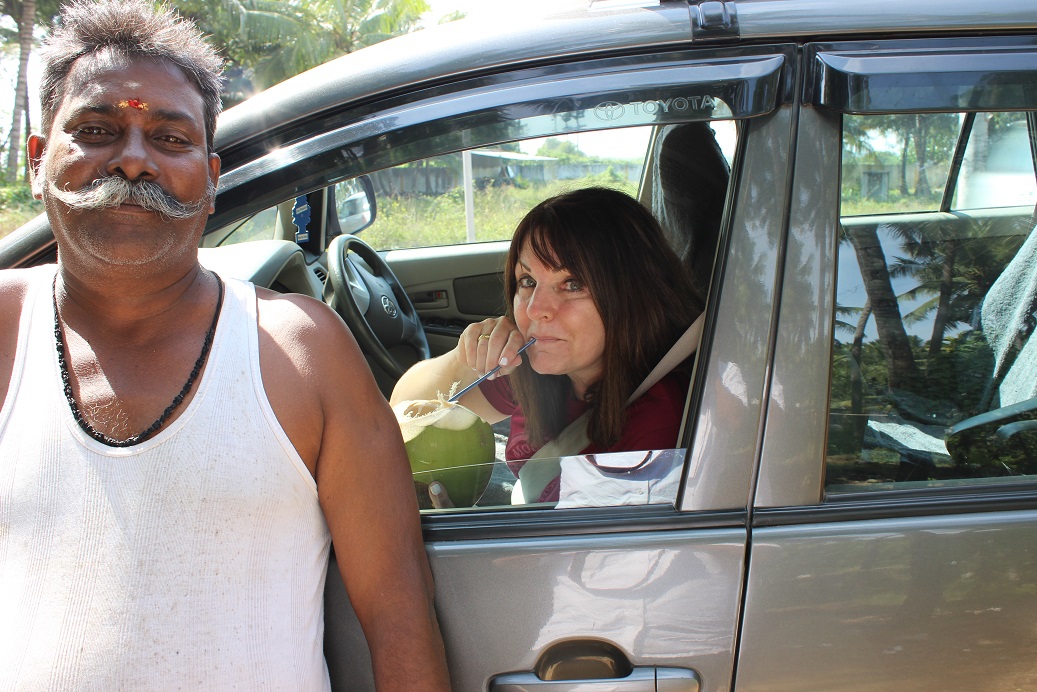
I know I look like I am enjoying it! But all I was thinking was how much water is in one of these coconuts? It is a crazy amount!
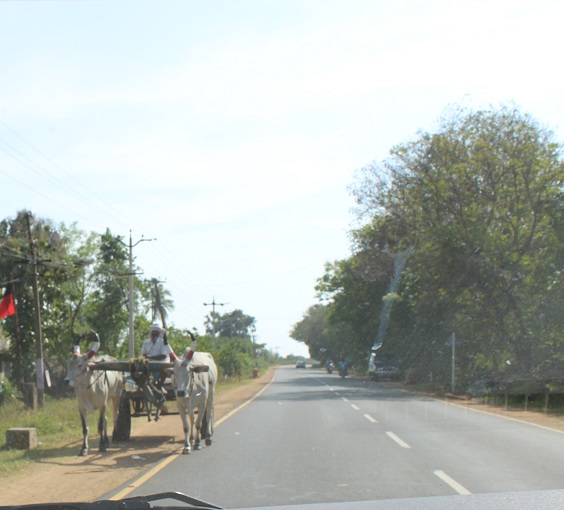
The bull carts with the bulls horns decorated are one of my favorite sites. I get so excited when I see them it is hard to compose myself and take a picture!
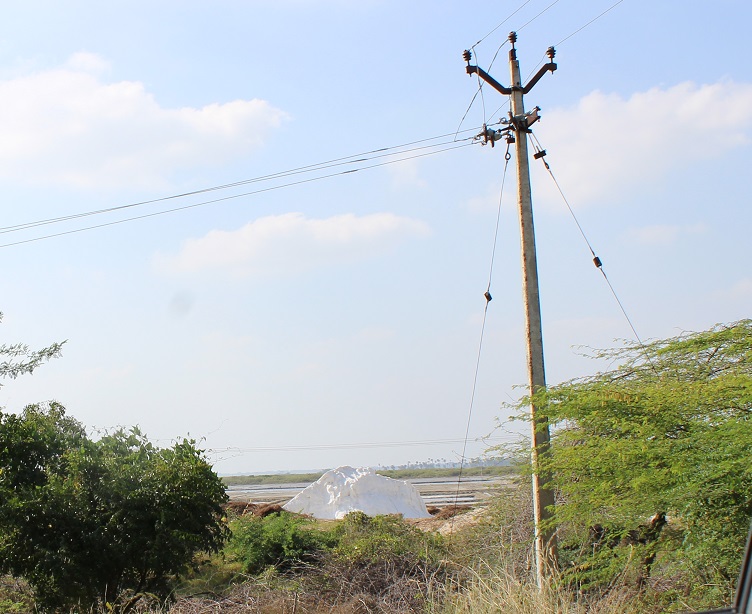
Here is a salt field. This salt is taken to place where they iodize it. Iodized salt is table salt mixed with a minute amount of various salts of the element iodine. The ingestion of iodine prevents iodine deficiency. Worldwide, iodine deficiency affects about two billion people and is the leading preventable cause of intellectual and developmental disabilities. Deficiency also causes thyroid gland problems, including “endemic goiter”. In many countries, iodine deficiency is a major public health problem that can be cheaply addressed by purposely adding small amounts of iodine to the sodium chloride salt.
Iodine is a micronutrient and dietary mineral that is naturally present in the food supply in some regions, especially near sea coasts, (remember we are still on the Bay of Bengal coast) but is generally quite rare in the Earth’s crust, since iodine is a so-called “heavy” element and abundance of chemical elements generally declines with greater atomic mass. Where natural levels of iodine in the soil are low and the iodine is not taken up by vegetables, iodine added to salt provides the small but essential amount of iodide needed by humans.
An opened package of table salt with iodide may rapidly lose its iodine content through the process of oxidation and iodine sublimation.
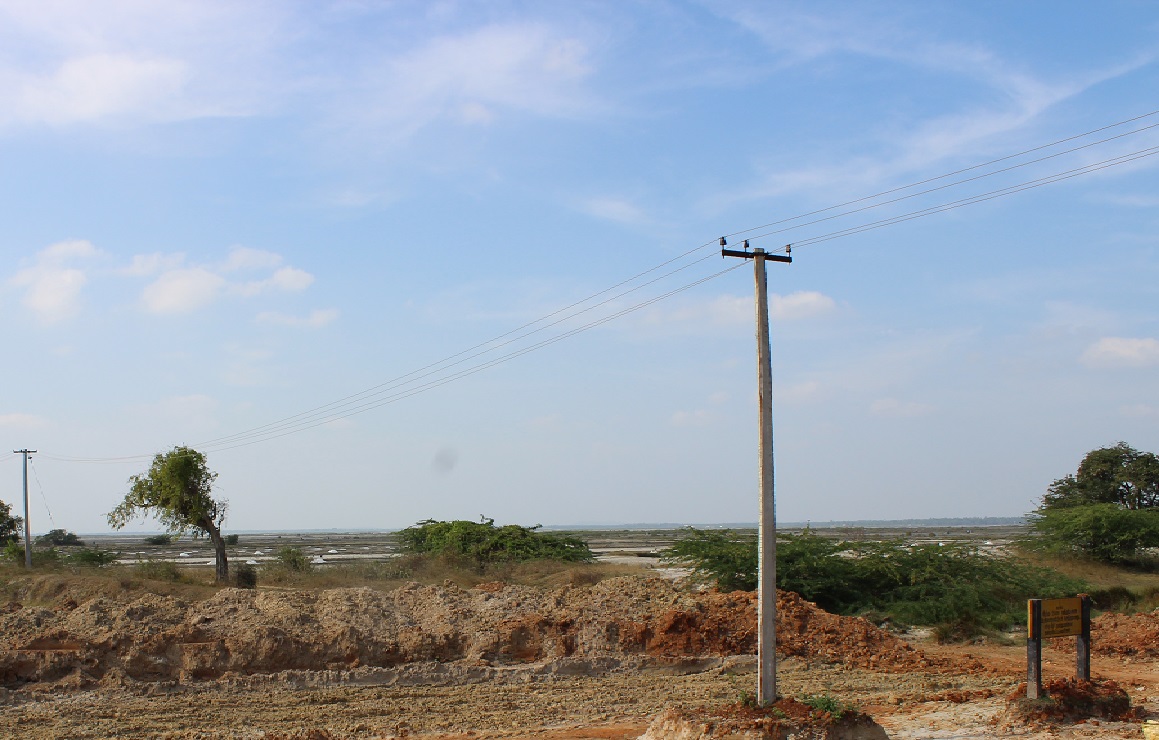
If you look into the distance, you can see the piles of salt in this salt field. Edible salt can be iodized by spraying it with a potassium iodate or potassium iodide solution. 60 ml of potassium iodate, costing about US$1.15 (in 2006), is required to iodize a ton of salt. Dextrose is added as a stabilizer to prevent potassium iodide from oxidizing and evaporating. Anti-caking agents such as calcium silicate are commonly added to table salt to prevent clumping. (“In Raising the World’s I.Q., the Secret’s in the Salt“, Donald G. McNeil Jr.; York Times. Retrieved 2008-12-04; “Iodine deficiency—way to go yet“, The Lancet. 12 July 2008; “Stability of iodine in iodized salt”, 8th World Salt Symposium, Diosady, L. L., and M. G. Venkatesh Mannar. Amsterdam: Elsevier. 2000.)
Main mineral wealth of the state is granite, lignite and limestone. The state is an important exporter of tanned skin and leather goods, yarn, tea, coffee, spices, engineering goods, tobacco, handicrafts and black granite. Tamil Nadu contributes to 60 per cent of the tannery industry in India. (http://www.tn.gov.in/tamilnadustate) No mention of salt so this must just be a very small industry here.
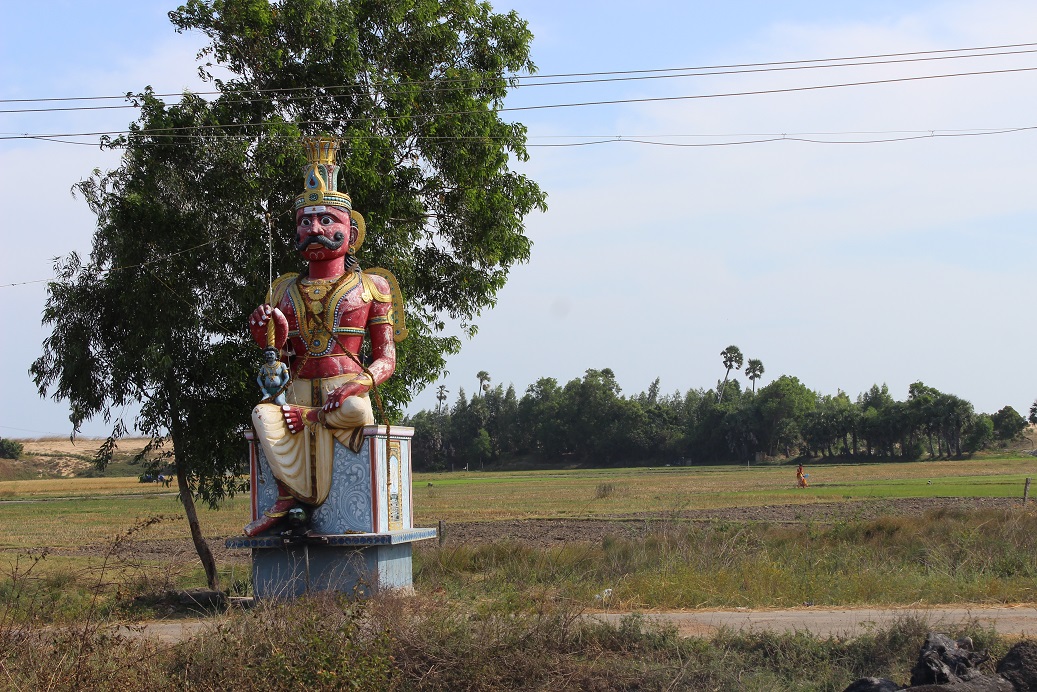
I just love how these statues are just built out in the middle of nowhere, but with the important job of blessing the fields! Just awesome!
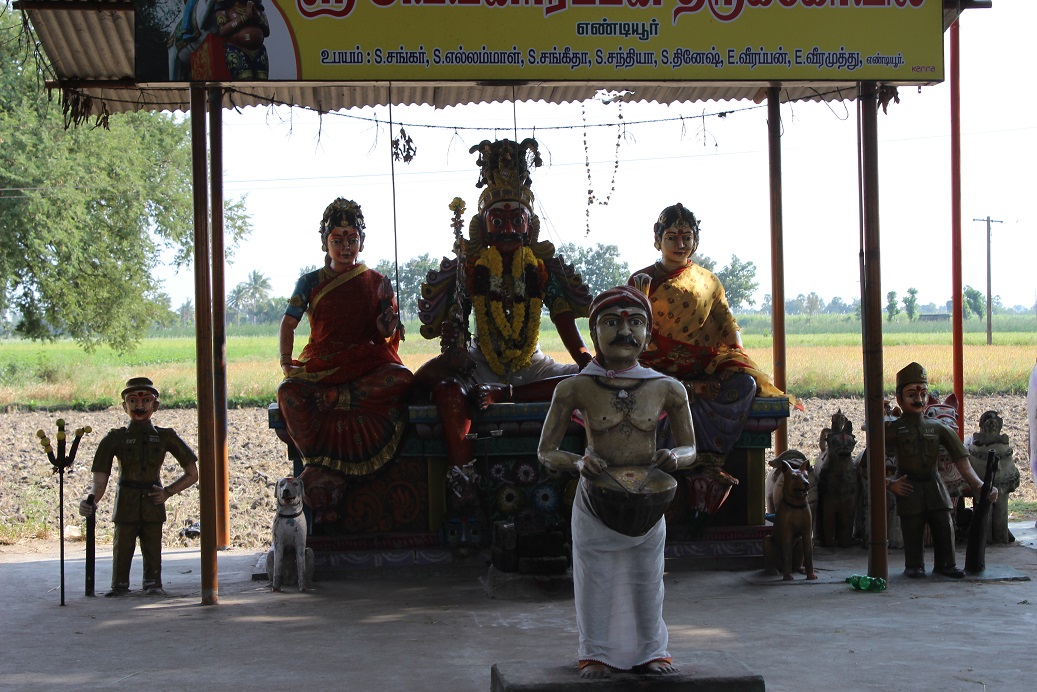
Further down the road we find another grouping of statues, hoping that these many Gods and Goddesses when bring this farmer a good crop.
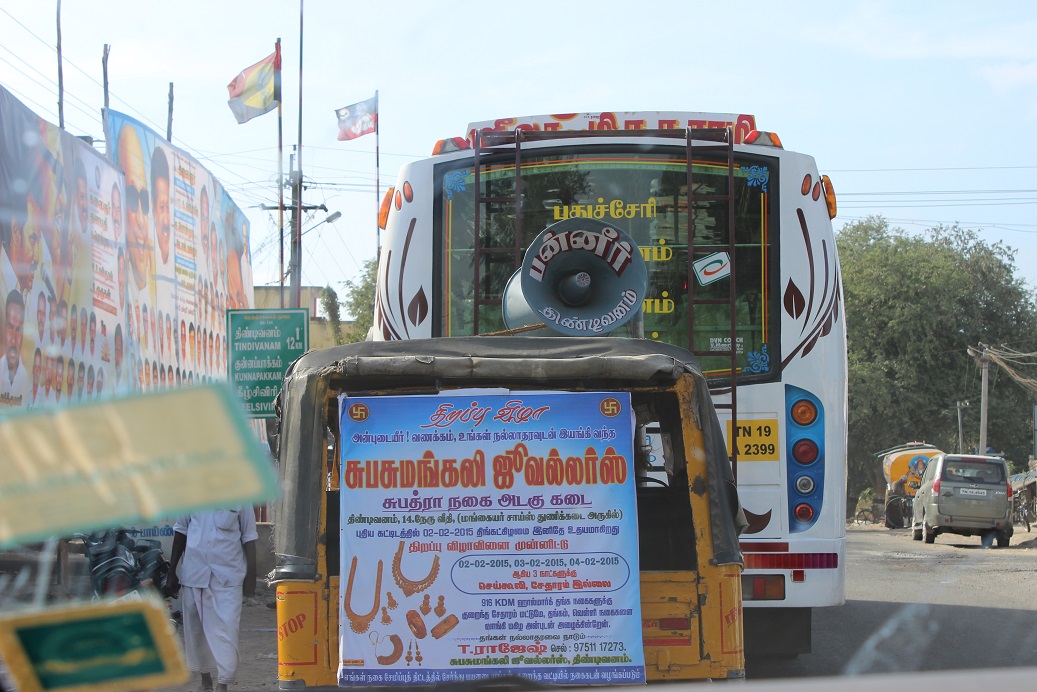
As we drove, we passed through many small towns. I love how they use everything, even the back of buses to advertise just like here in the U.S. Now you know the traffic is slow if this advertiser thought you could read through this entire ad!
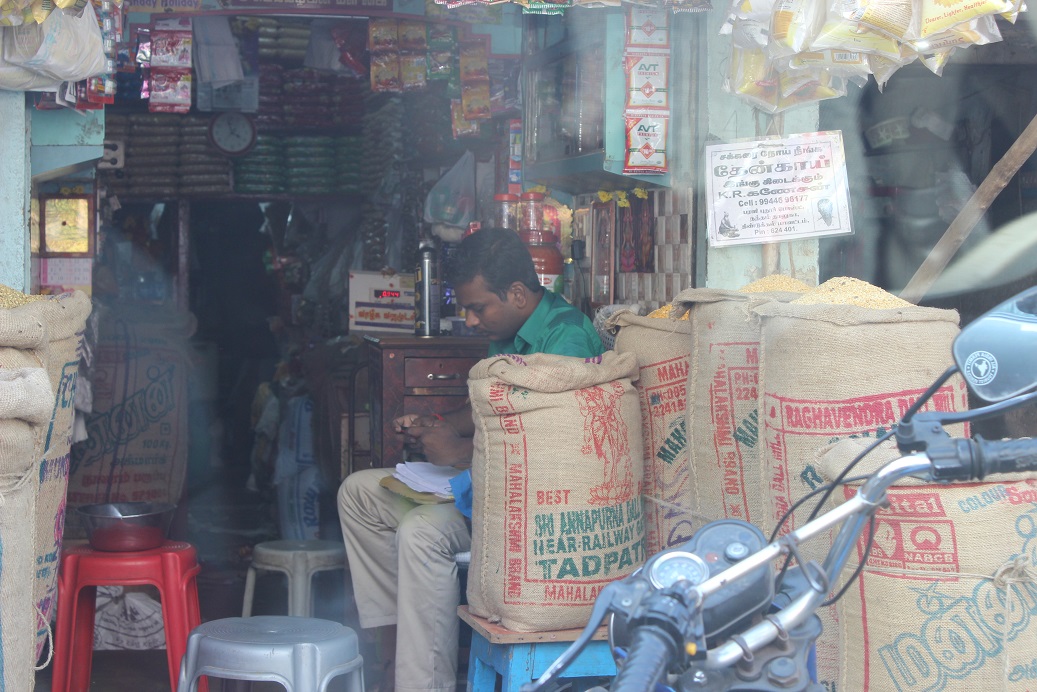
In the next town, we see some grain merchants.
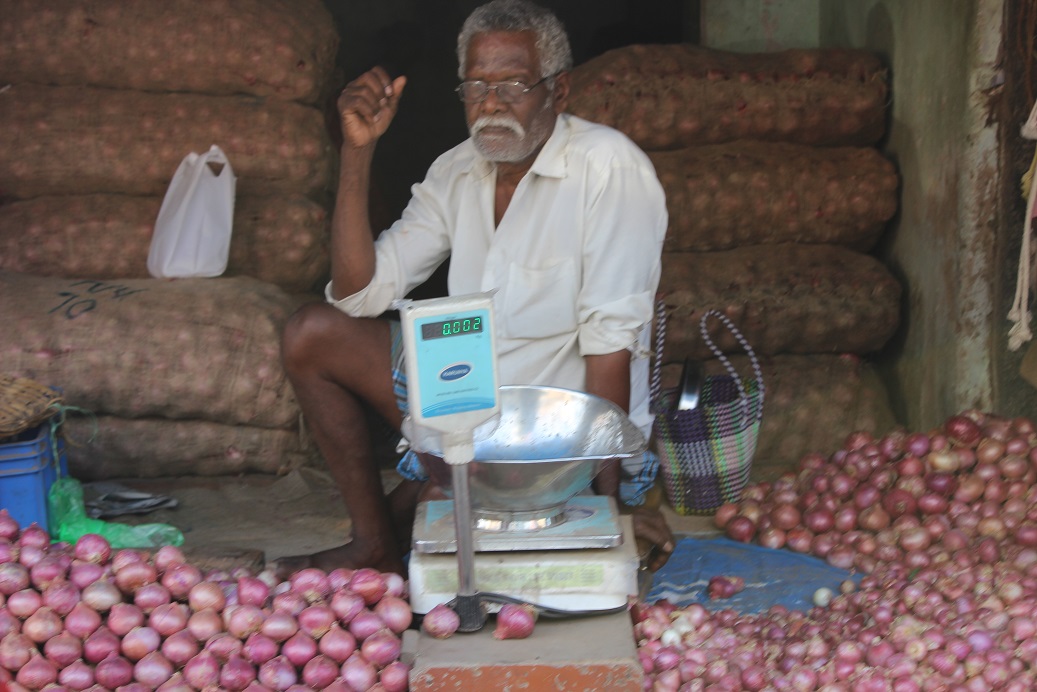
This red onion dealer sits patiently to sell his products. India produces almost 100% of its food. The only things it imports is basically onion, and garlic (just because they can’t grow enough) and Washington apples!
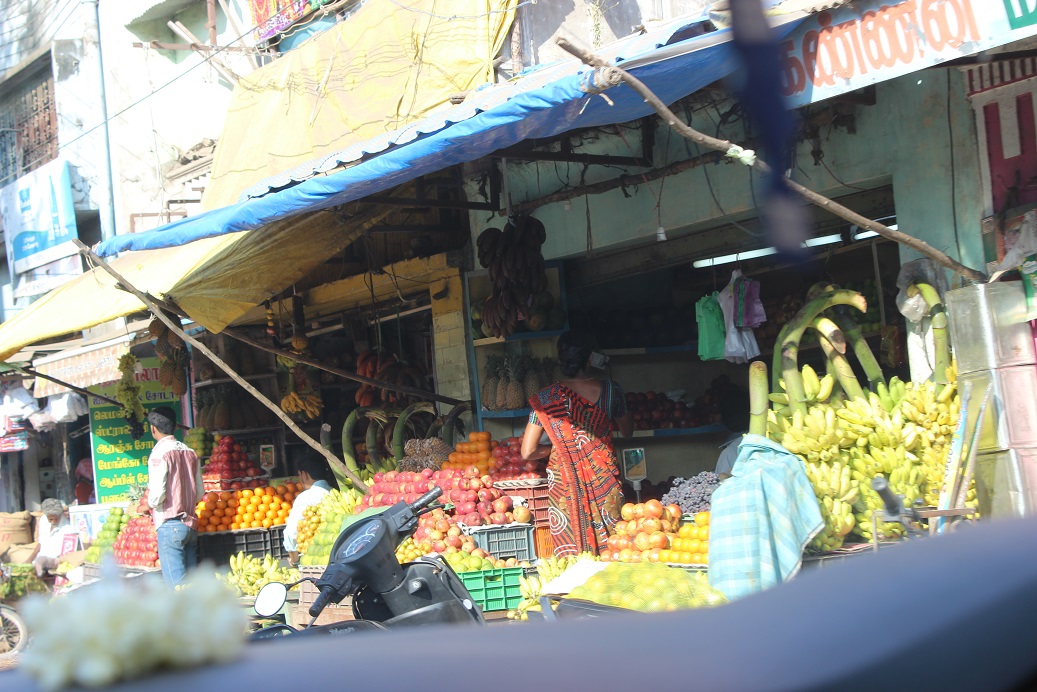
This was a beautiful fruit market. Notice all the motorcycles in the pictures! Major form of transportation…everyone that I’ve talked to owns one.
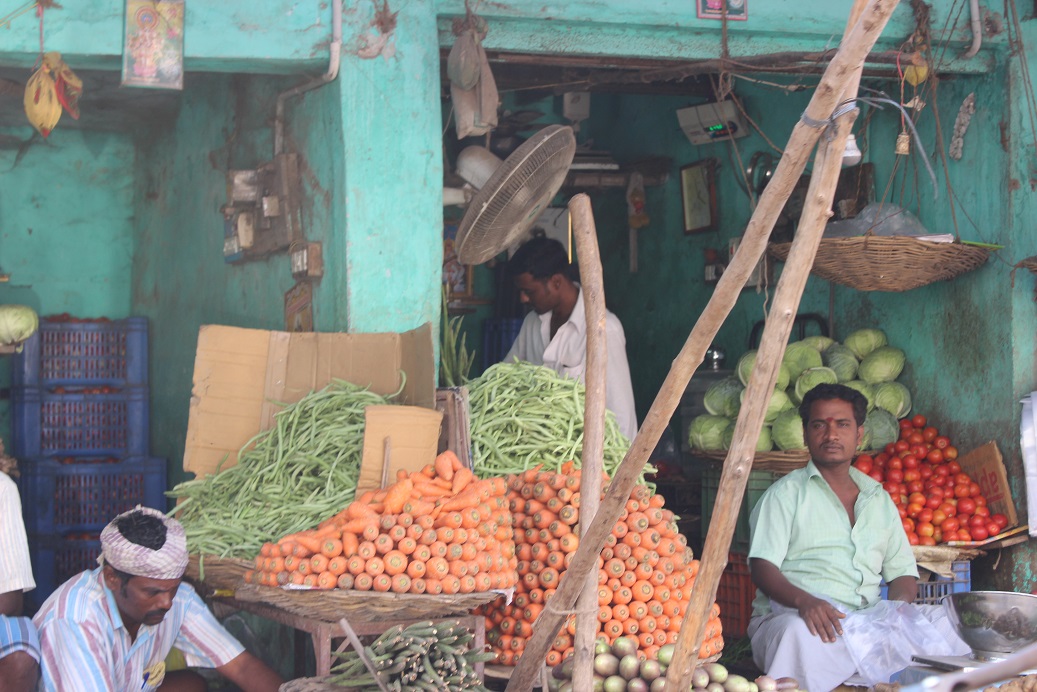
The vegetables here are amazing, look at the size of those beans! But the wonderfulness of this picture is this man in perfect sukasana (easy sitting pose in Yoga)!
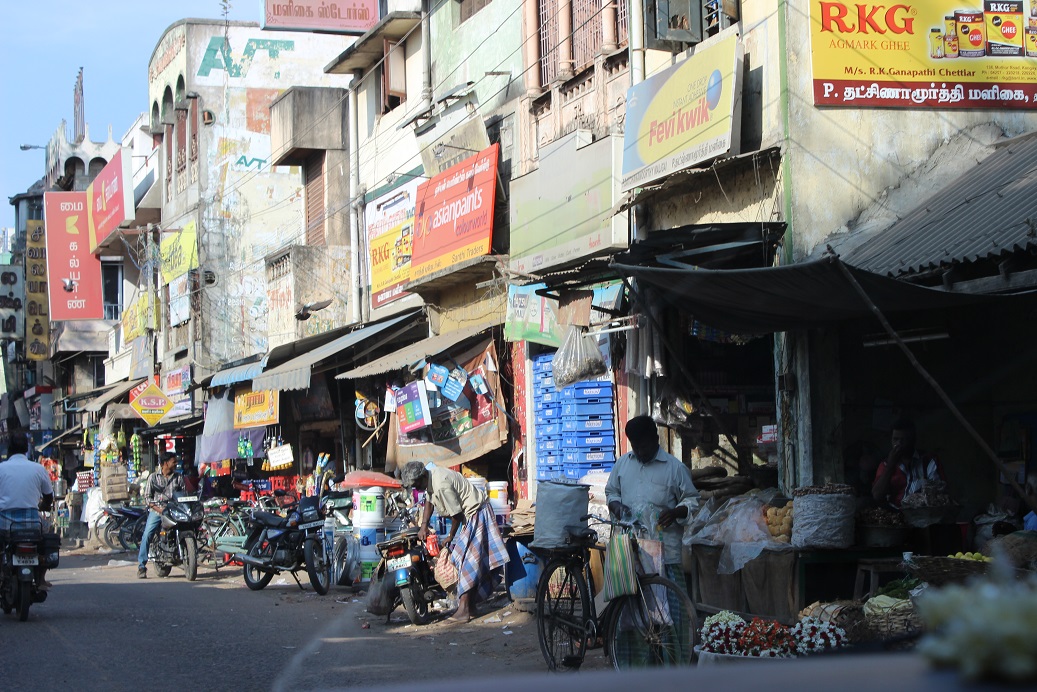
All kinds of products are sold on the streets. Yes there are shopping malls (with Prada and Gucci), but the majority of what you find is more in this fashion!
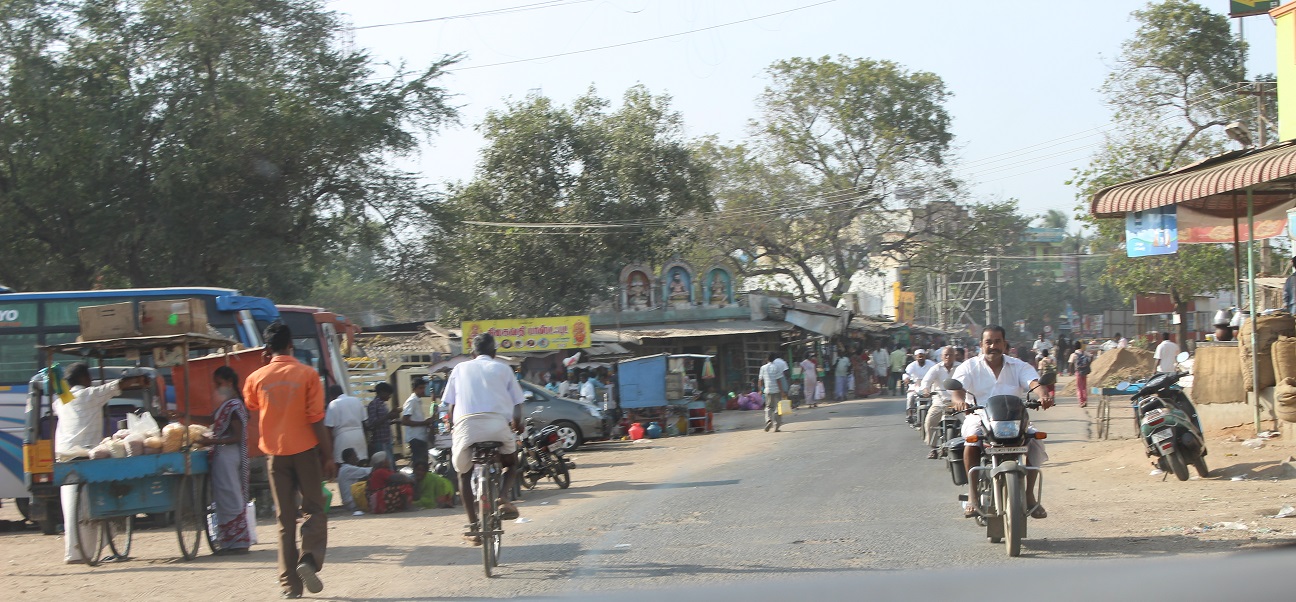
Everyone busily going about their day!
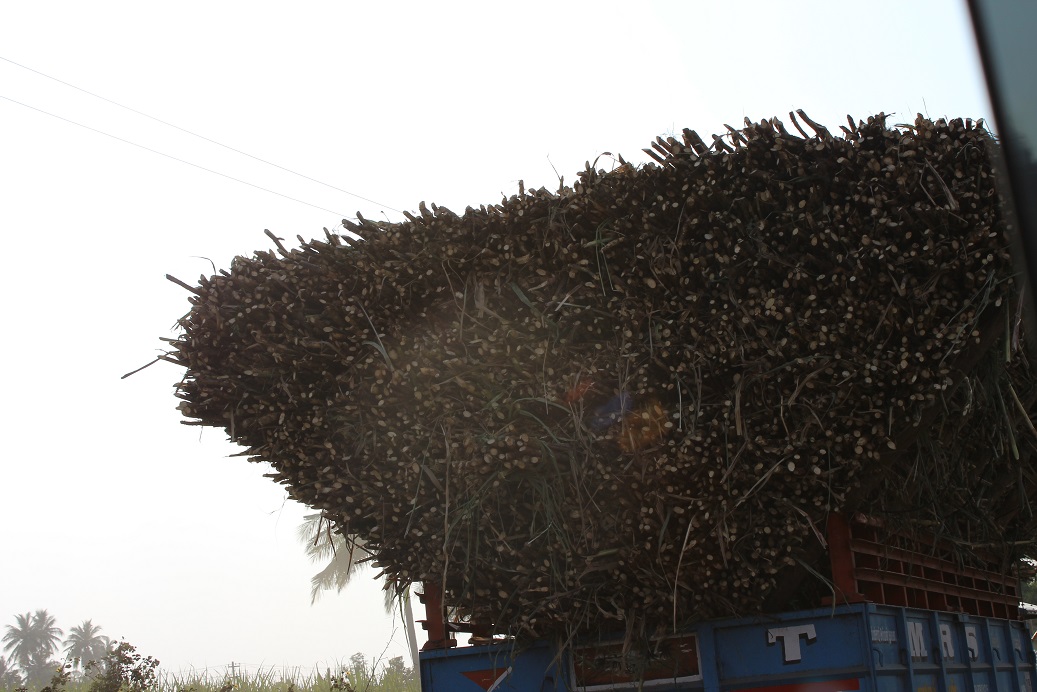
It was sugarcane harvest and we saw many, many trucks like this! How do they keep the sides from falling down?
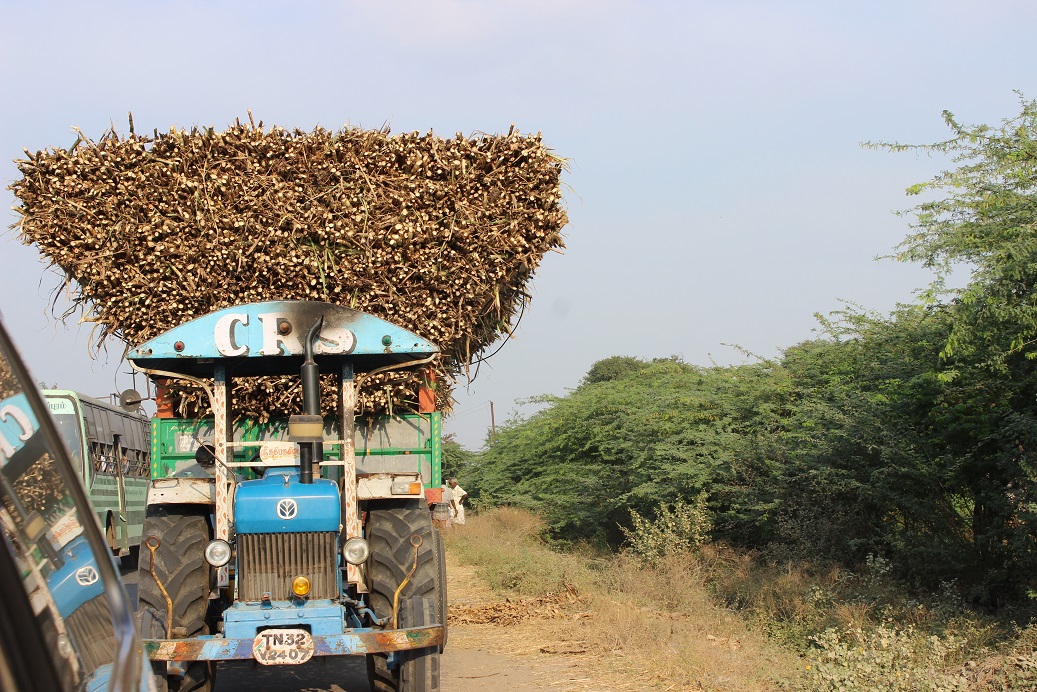
Because of the climate, there are three sugar cane harvests each year!
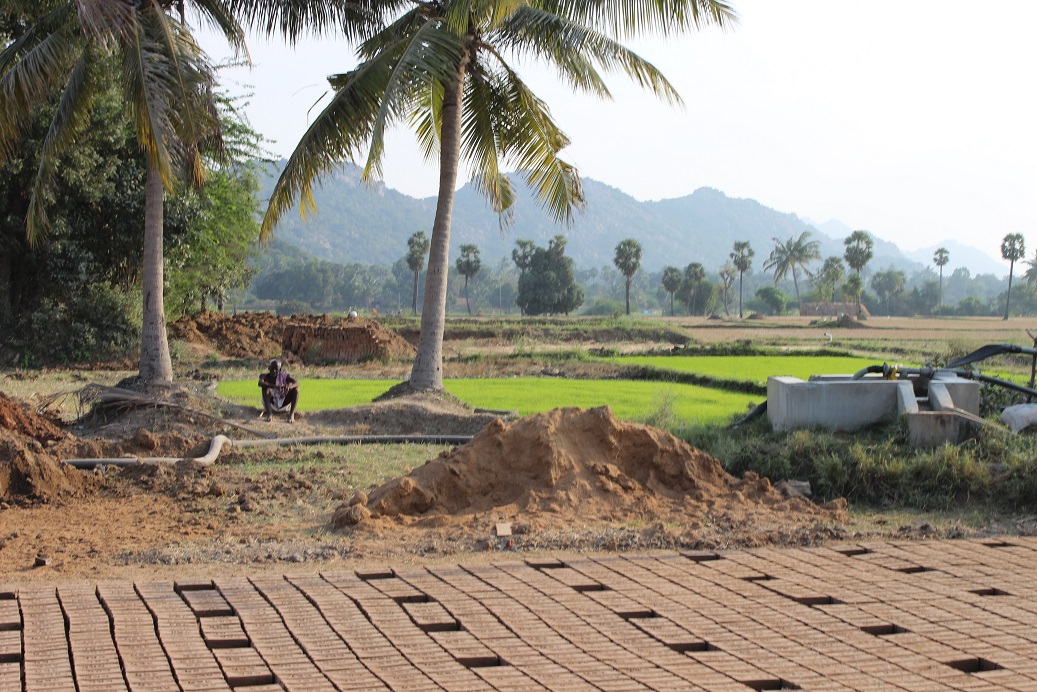
We drove up upon this brick making business,
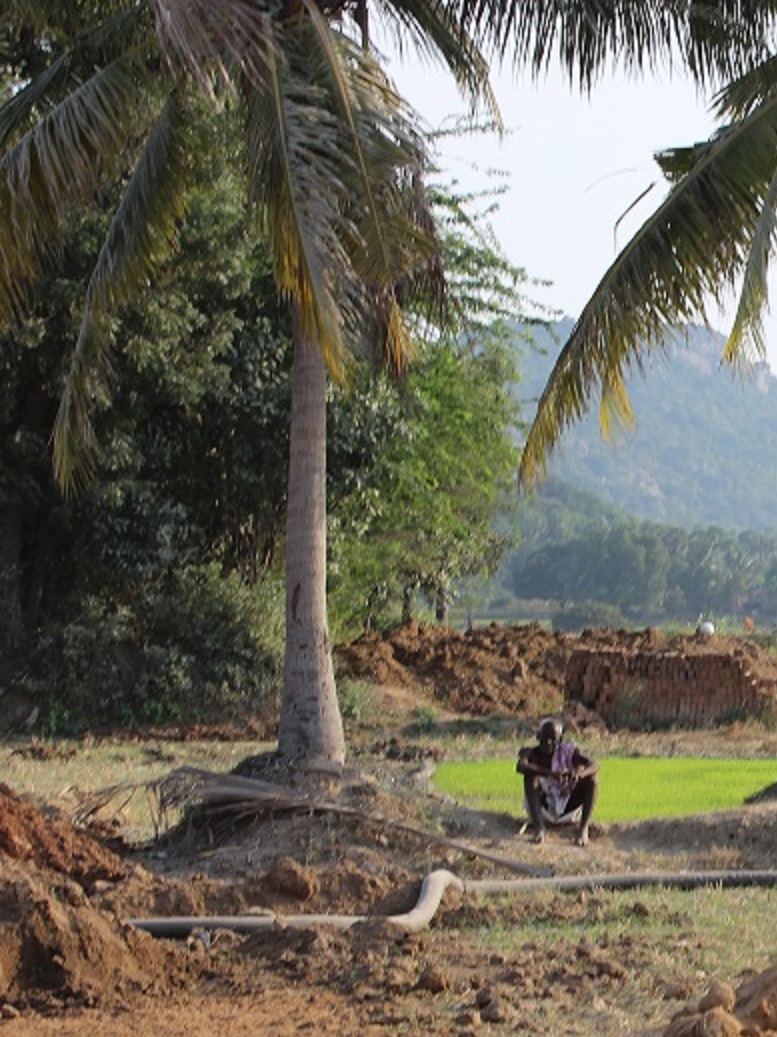
But it was this guy that made it interesting.
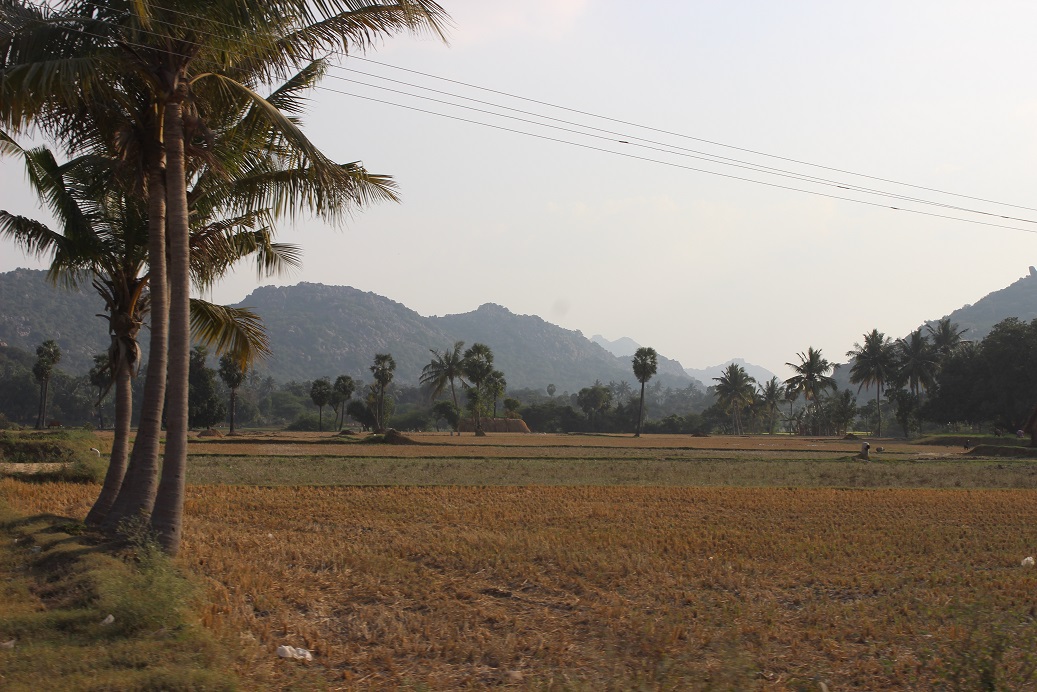
Looking out over one of the harvested sugar cane fields; it’s so beautiful.
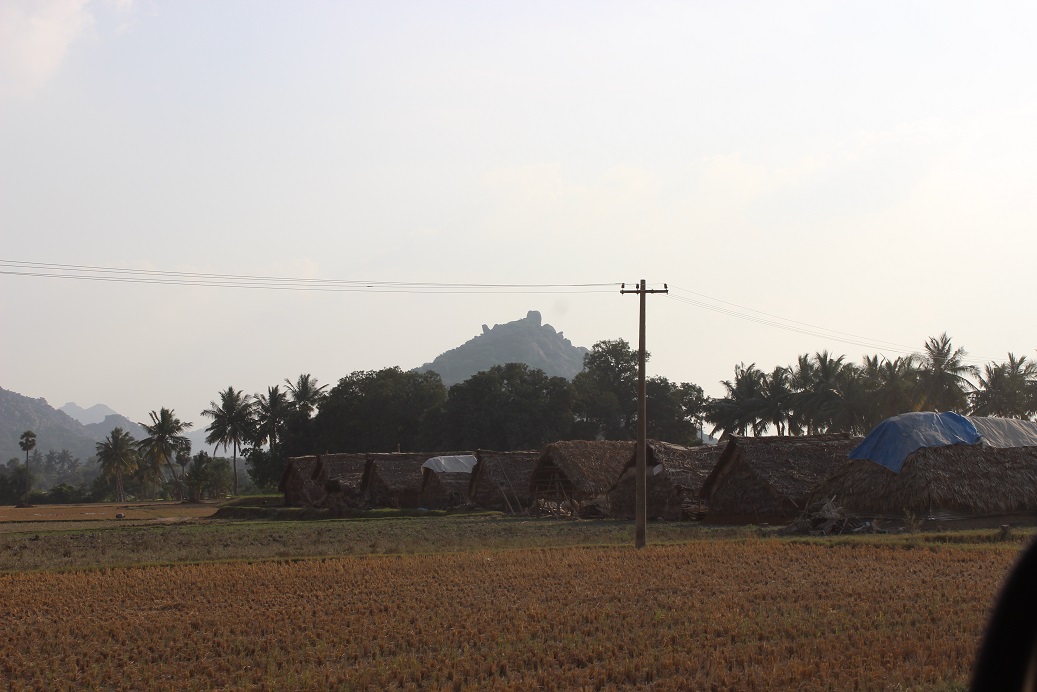
Here were some of the huts for the farm workers.
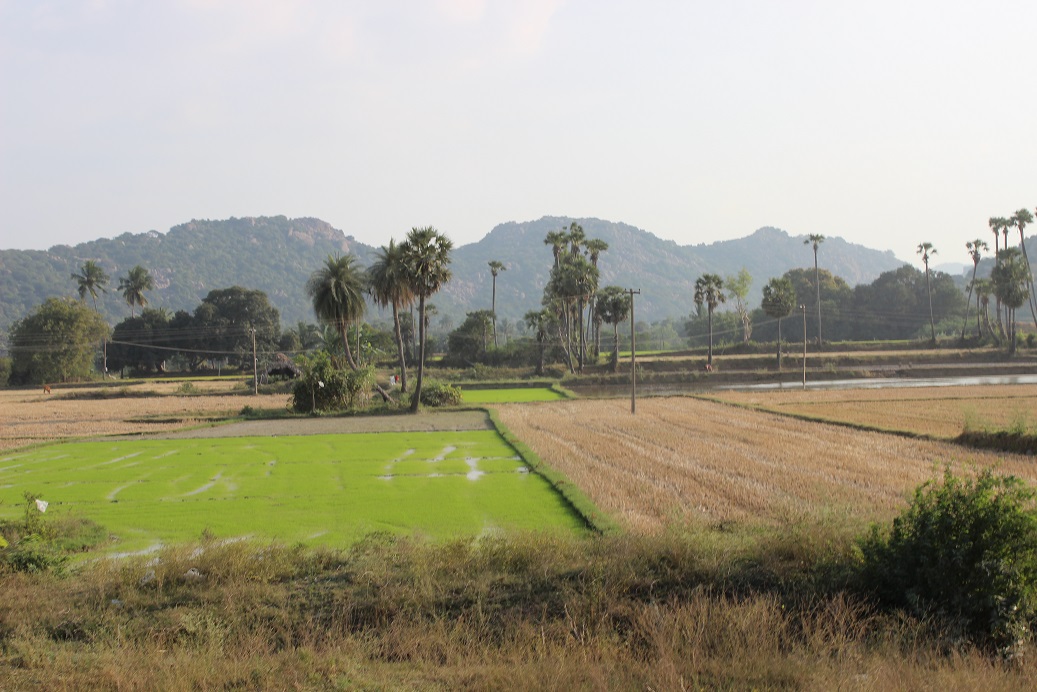
Two fields, one rice (so green) and to the right, sugar cane.
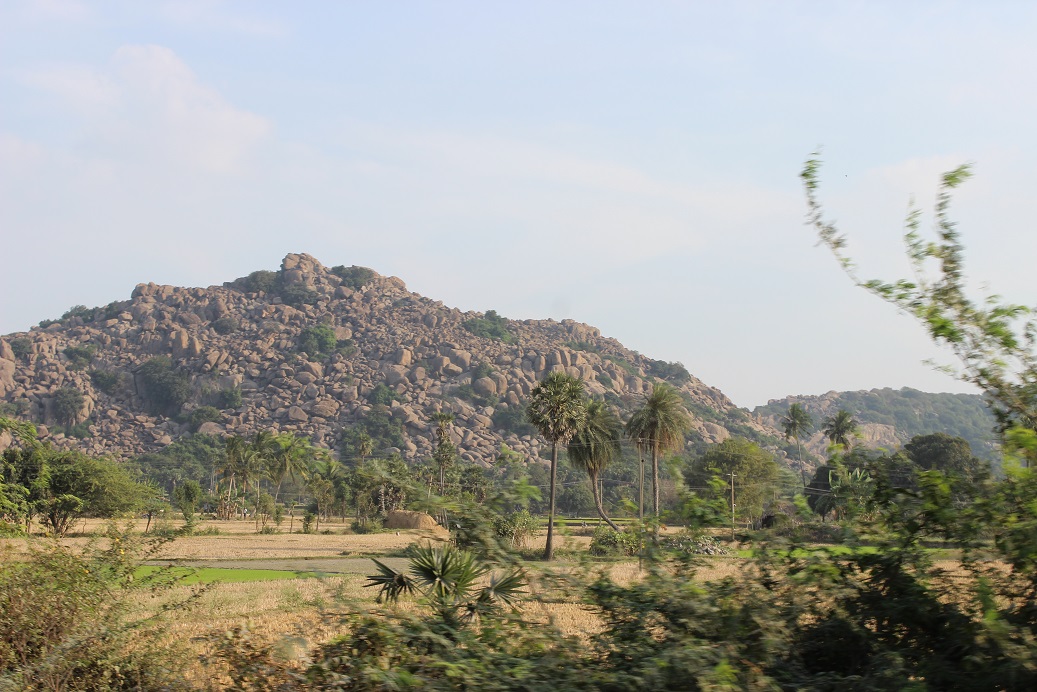
I began to notice how different the hills looked. It is as if God just took a handful of stones and made a pile.
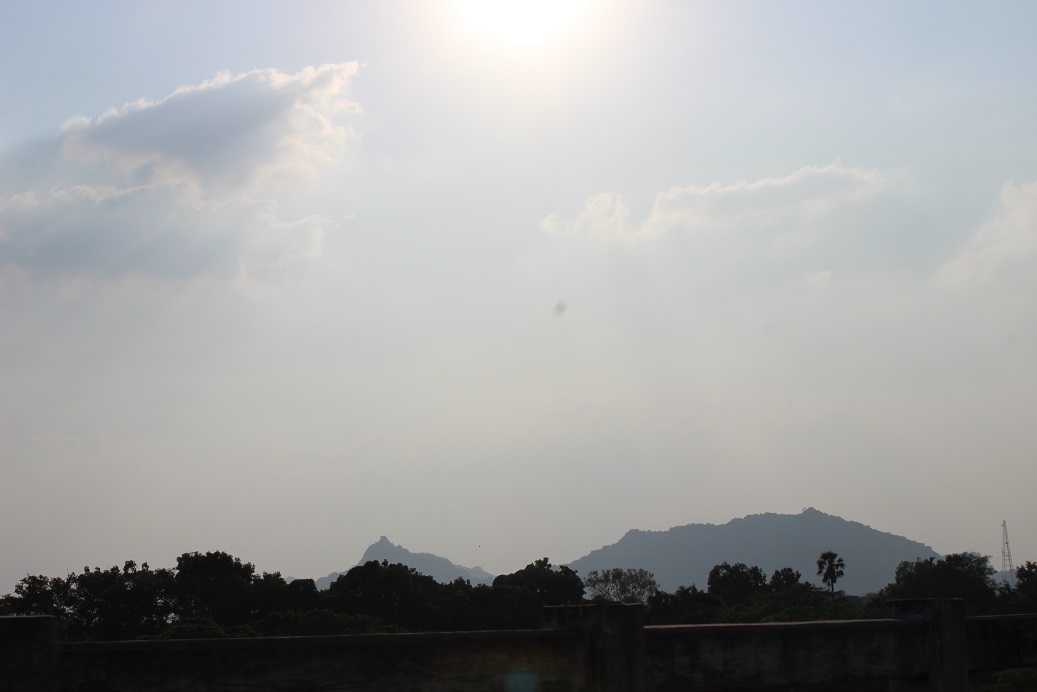
Speaking of God!
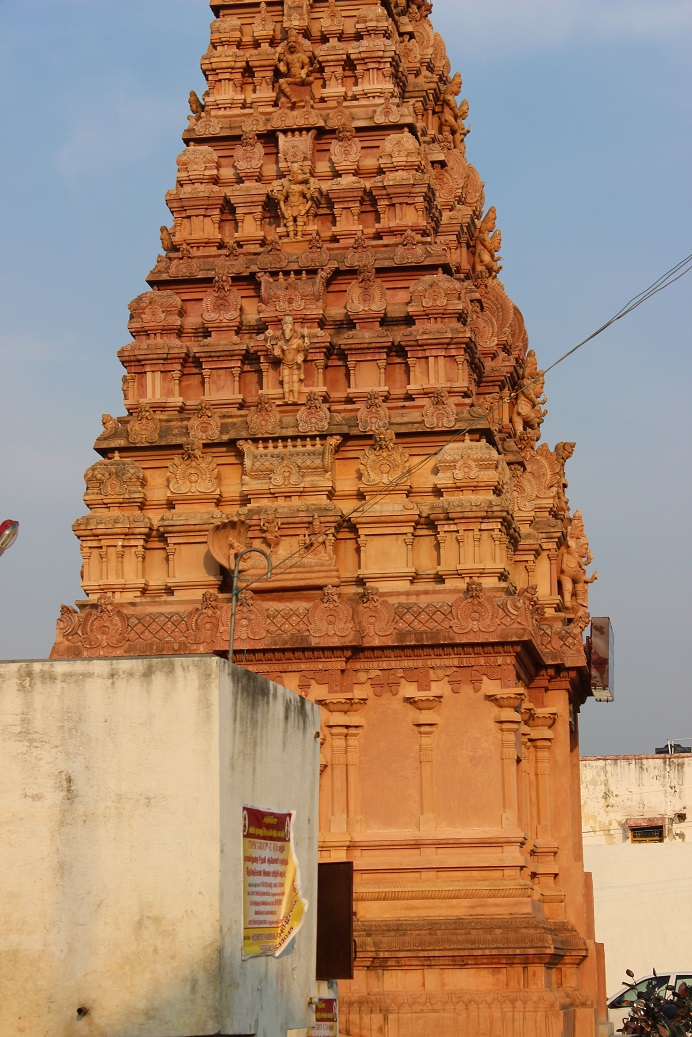
This next town, Tindivanam. was originally named for a shivan temple. Tindivanam is the home of Shri Lakshmi Narashima Perumal Temple, which is more than 1000 years old.
In the early period of Cholas Saivism (Saivism is one of the four most widely followed sects of Hinduism, which reveres the God Shiva as the Supreme Being) took prominence and Vaishnavism (Vaishnavism also is one of the major branches of Hinduism along with Shaivism, Smartism, and Shaktism. It is focused on the veneration of Vishnu) was suppressed by it. Even amidst the situation prevailed in south India, the temple of Lakhsmi Narasimha enjoyed patronage and was well governed. Later at the glorious era of Vijayanagara nayaks (military governors), Vaishnavism flourished and given much importance in both politics and as a religion. At this time the Lakhsmi Narasimha temple became important along with Sriperumbudur which is a Divya desam (Divya Desam refer to the 108 Vishnu temples that are mentioned in the works of the Tamil Azhvars (saints). Divya means “premium” and Desam indicates “place”. Of the 108 temples, 105 are in India, one is in Nepal, and two are outside the Earthly realms. The Divya Desams are revered by the 12 Azhvars in the Divya Prabandha, a collection of 4,000 Tamil verses. While most Divya Desams follow Thenkalai mode of worship, some follow Vadakalai). And the temple is also nearer to Sriperumbudur. Vijayanagara Nayak Emperors patronized it and gave many villages as charter to the temple’s development and as well as the religion.
The temple is a fine specimen of the Vijayanagar style of architecture with delicately sculpted and carved pillars. Architecture in the temple made one think that it belonged to the Vijayanagar period, there are inscriptions dating back to the reign of Chola kings. Archaeologists consider those inscriptions in the Andal shrine basement as more ancient and belonging to the period of Kulothunga Chozha I and Vikrama Chozha I. They speak about their constructing the Madurantaka Vinnagar temple in Madurantaka Nalloor (the present Madurantakam) and installing the idols of Rama, Sita and Lakshmana in it and the grants made by them for the daily conduct of poojas (prayers).
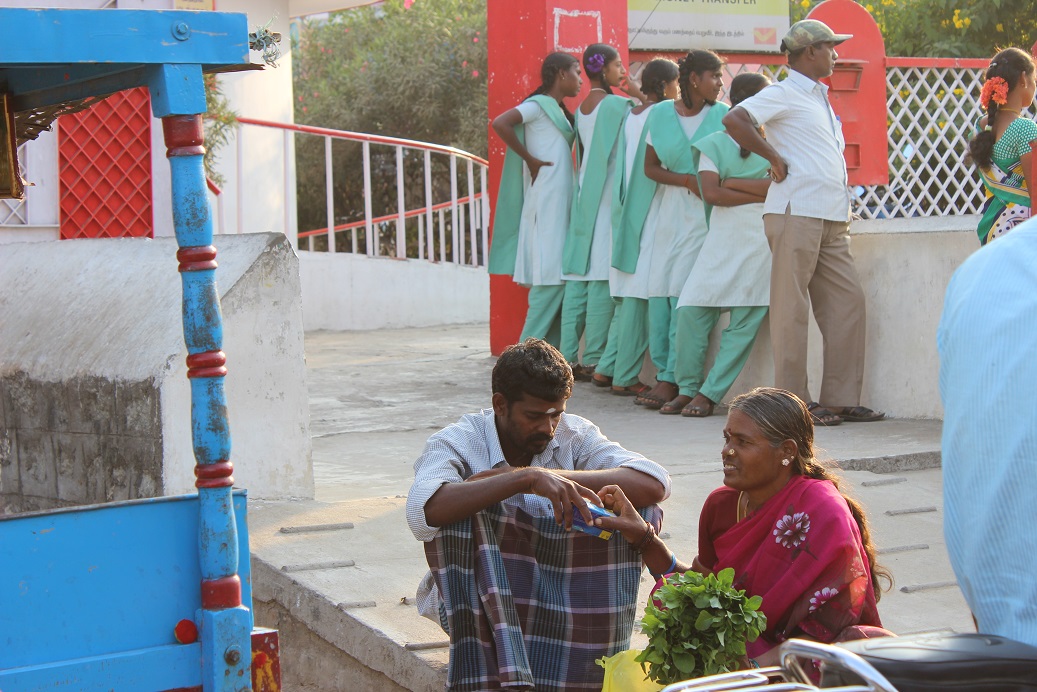
Everyting about this picture is great, the school girls in the background, and the man and women in the front, talking while she waits for someone to buy her basil.
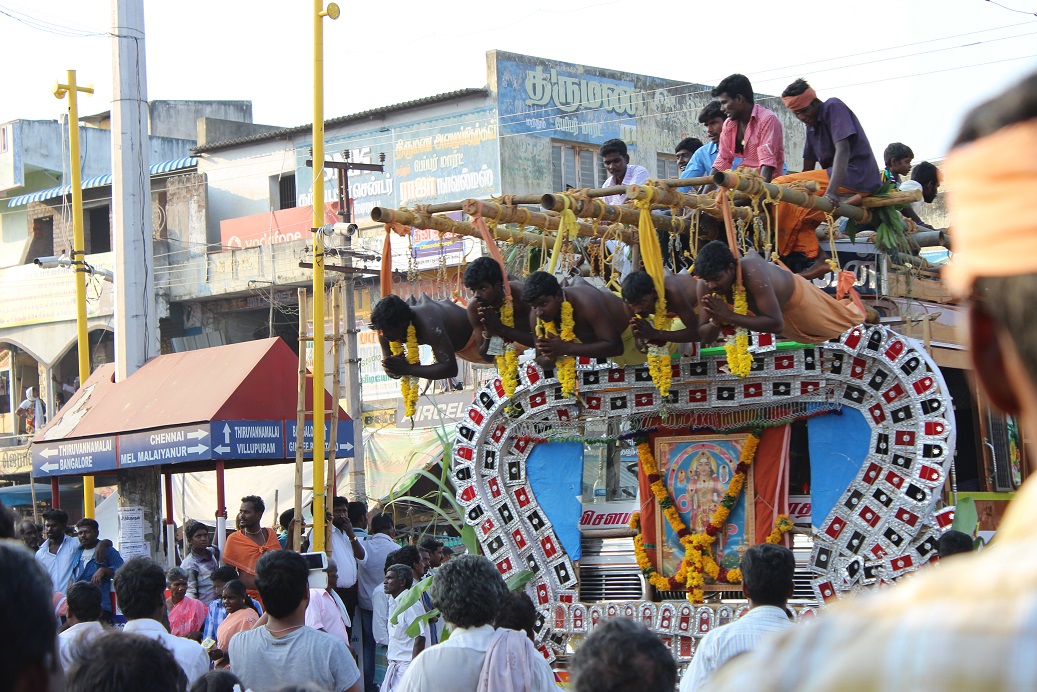
There was a big celebration in town that had caused a traffic jam. I jumped out of the van to get this picture over about a hundred people. I love how passionate they are even in their float making!
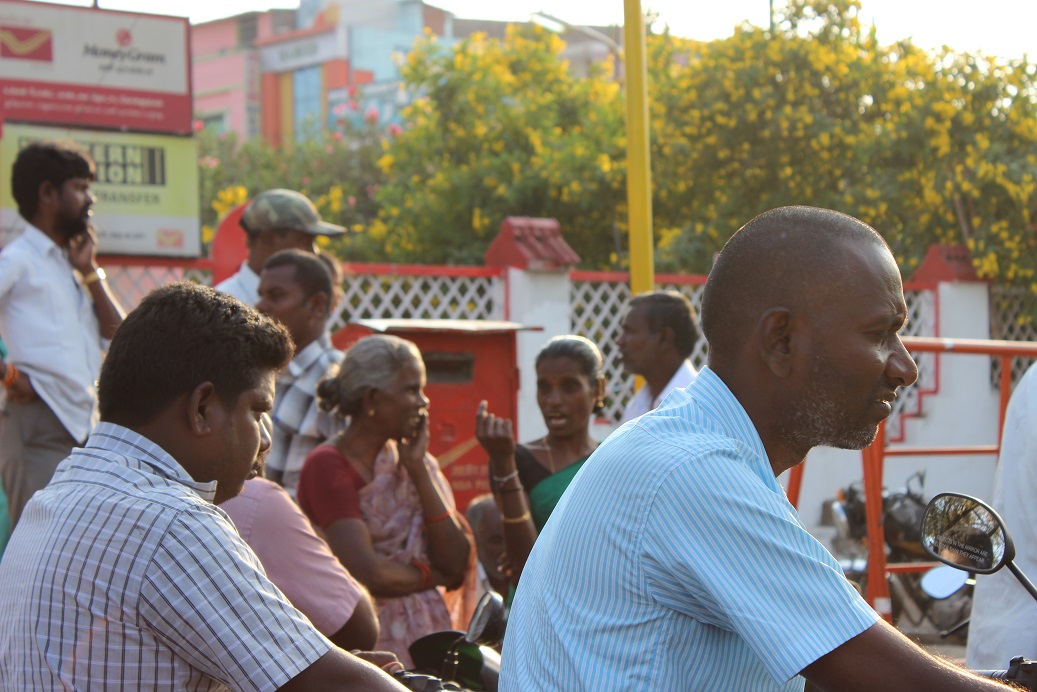
The traffic jam lasted for some time, and even though the vehicle horns were blowing, no one seemed upset having to wait on the parade.
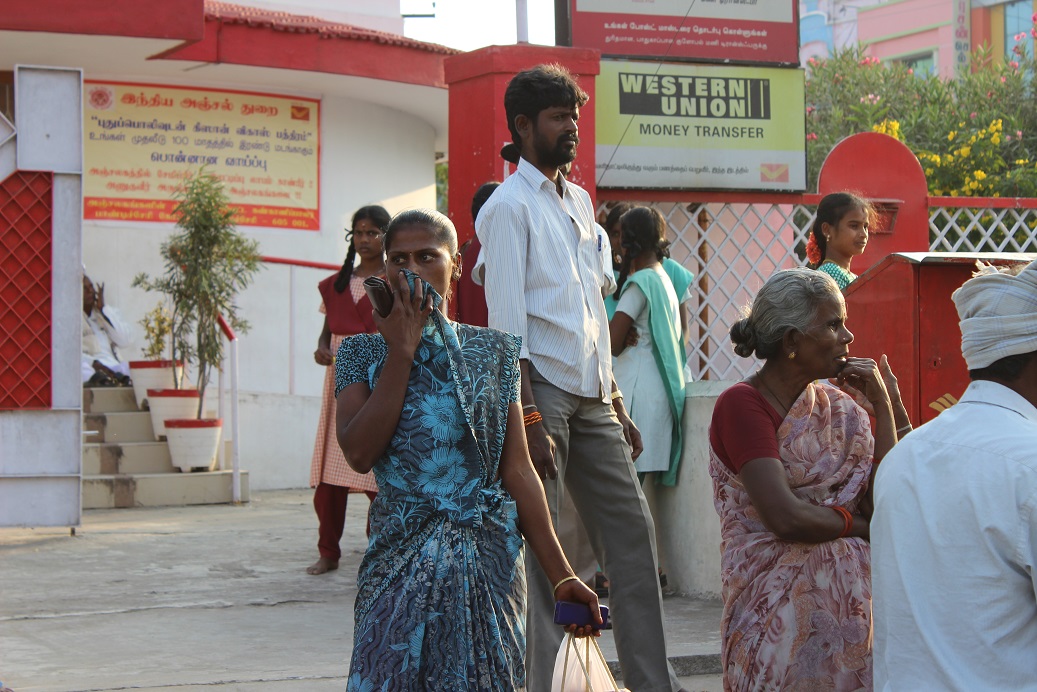
Loved this blue sari!
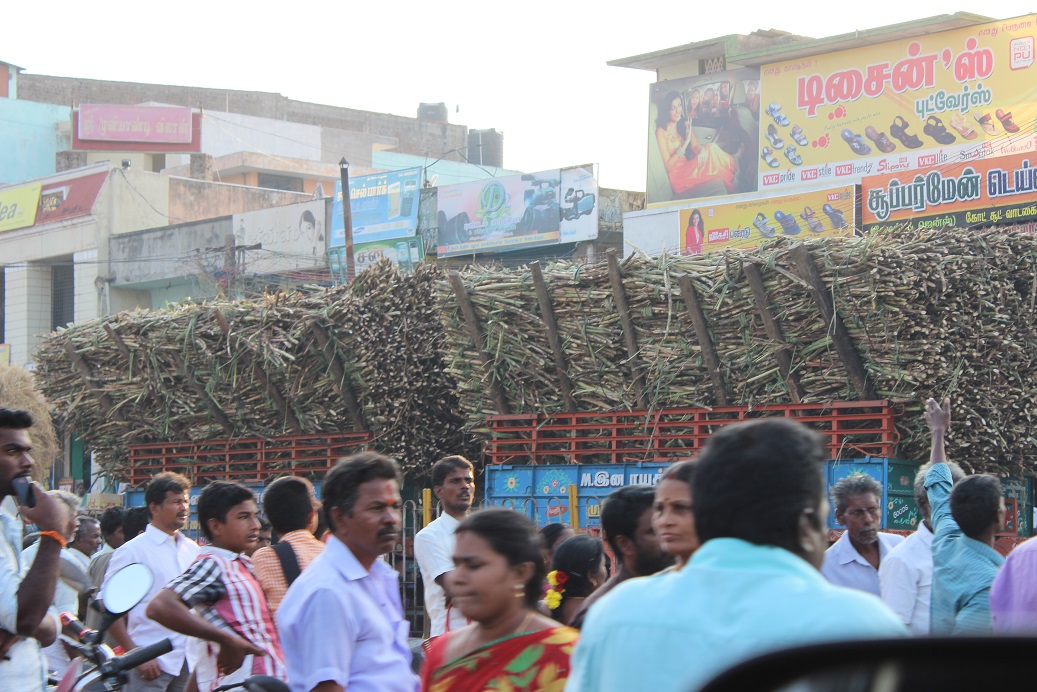
I wondered if part of the celebration had to do with the sugar cane harvest?
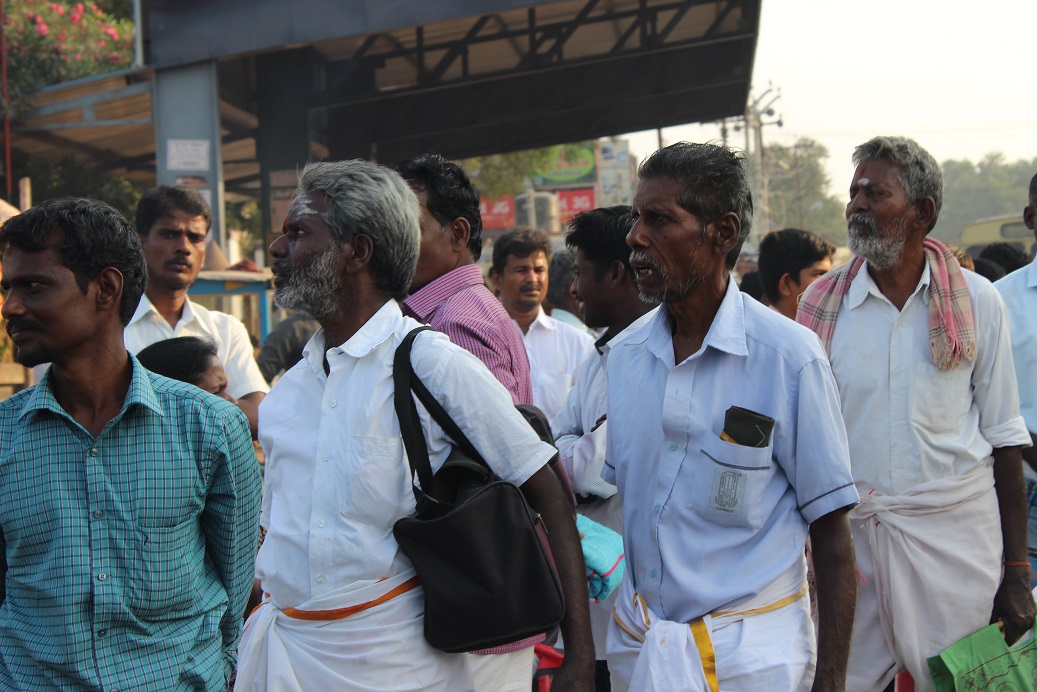
I have talked about the women being interesting, these men also were.
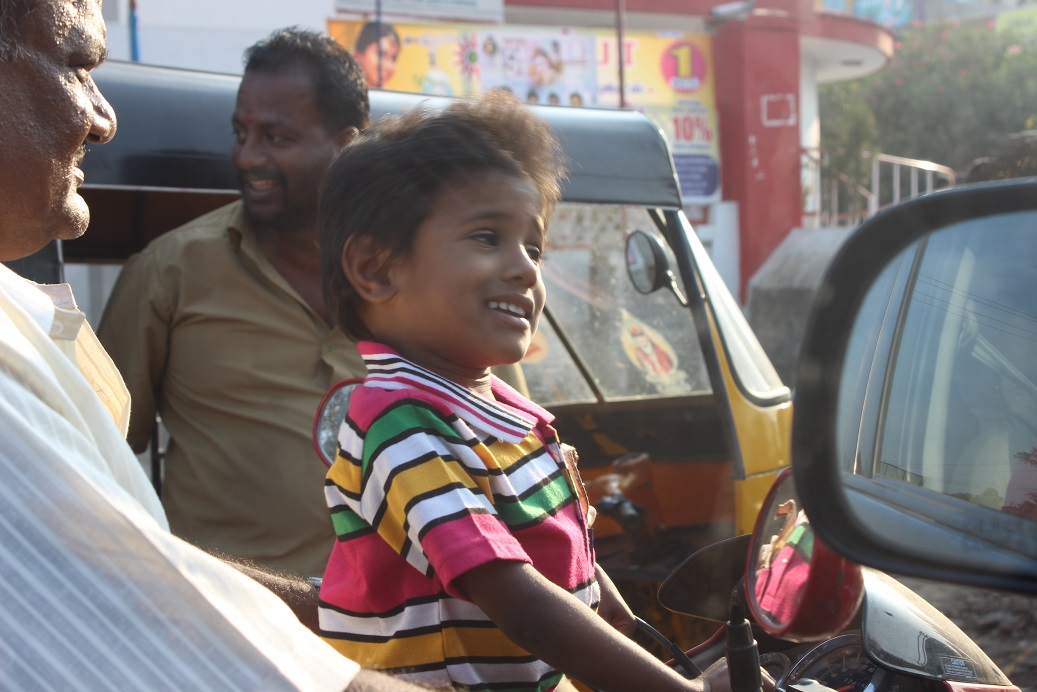
This little guy just needed his picture taken. So cute and happy!
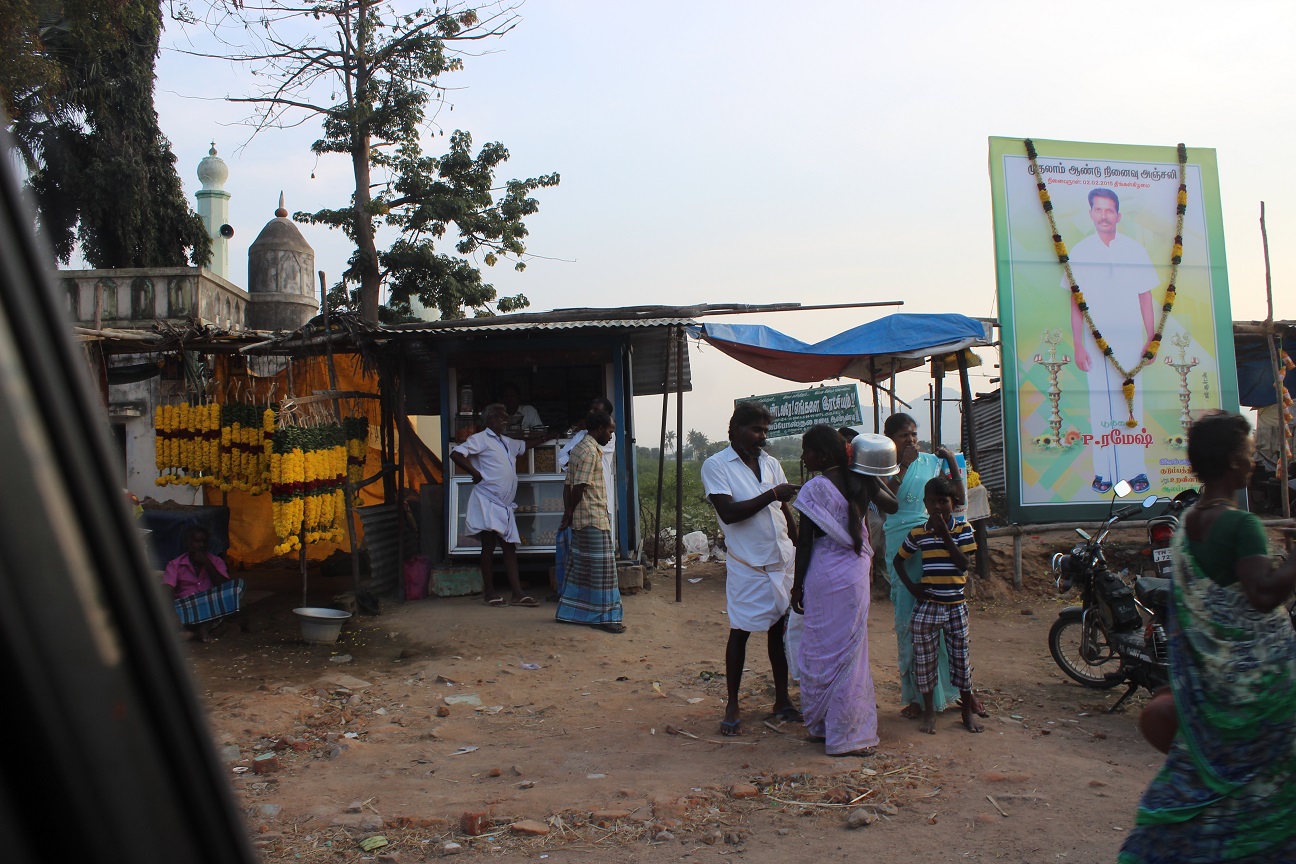
Life just happening. In the background strings of flowers, a couple talk, and on the right a political poster.

Off in the distance another beautiful hill temple. I wish we could have stopped by, buy time was a problem. We still had a long way to drive and there was that “other” temple we needed to see.

I loved how flat the land was and then there was just this hill; it looked so odd.

Another amazing hill with some banana trees far away from the road.
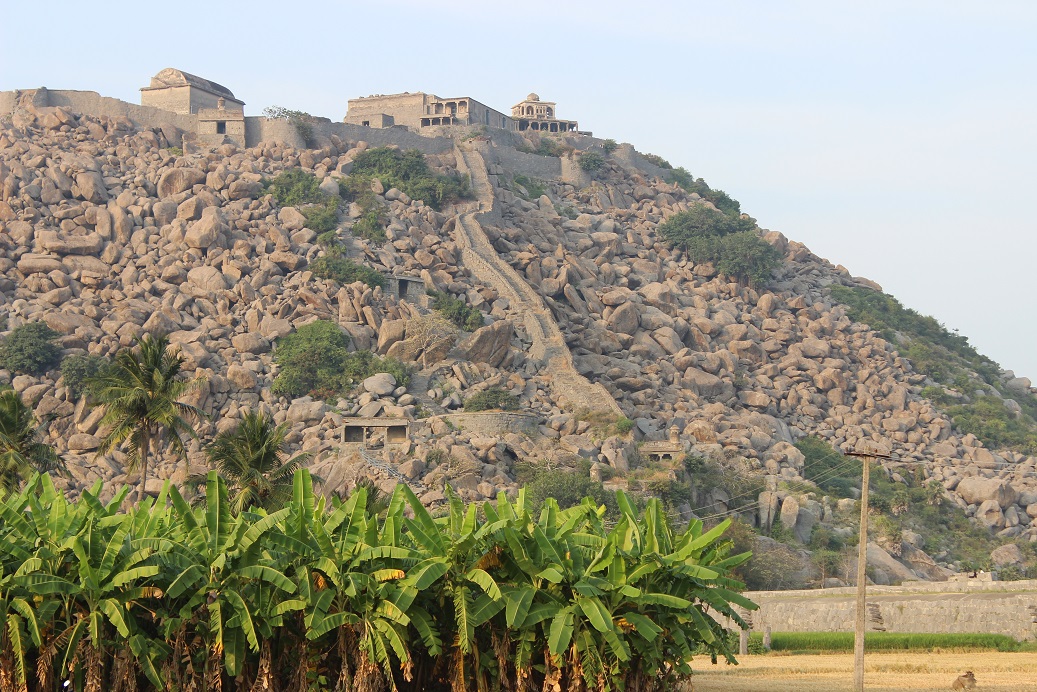
Another great hill top temple on the crazy boulder hill. I wanted to take the stairs, but not enough time (whew!)

As we got closer to the sugar cane fields, we saw a lot of monkeys. This little mother must have thought I would feed her.

One of my favorite pictures– this rice patty looks eerie.

It is late afternoon and we are just coming into the town where this temple is that we have gone out of our way to see. The traffic was getting bad and we were stopping every few yards. I saw this great little cemetery along the road and thought it wasn’t getting much respect. I did not know if taking a picture of it would be more of the same. But I took the chance with the intention of honoring those that lie at rest.

As we got deeper into town, we noticed tons of people all walking one direction. Where were they going? They were going to the temple of course.
Tiruvannamalai is a town in the Indian state of Tamil Nadu with a population of 144,278 in 2011. It is the administrative headquarters of Tiruvannamalai District. Tiruvannamalai is named after the central deity of the Annamalaiyar Temple, Annamalaiyar. The Karthigai Deepam festival is celebrated during the day of the full moon between November and December, and a huge beacon is lit atop the Annamalai hill. The event is witnessed by three million pilgrims. On the day preceding each full moon, pilgrims circumnavigate the temple base and the Annamalai hills in a worship called Girivalam, a practice carried out by one million pilgrims yearly. Even though we were not here at the time of the Darthigai Deepam festival, we were here during the full moon. Darshan tells me that people will travel for days to get here for the full moon and walk around the base of this mountain all night.
The significance of Girivalam (Circumambulation) in most of the holy places the Deity is found atop the hill. But here the Holy hill itself is the Deity (Lord Annamalaiyar) and is worshipped. “Arunam” means sun and denotes the red color of fire. “Asalam” means “Giri” or “malai” (mountain). Thus “Arunachalam” means the Holy hill which is red in color.
The Annamalai Hill was Agni (fire) during Kirthayugam, was Manikkam (Emerald) during Threthayugam, was Pon (Gold) Dwaparayugam and rock during Kaliyugam. There are eight lingams located at the eight directiions and provides an octagonal structure to Thiruvannamalai Town.
Located on the foothills of Annamalai hills, Tiruvannamalai has been ruled by the Pallavas, the Medieval Cholas, the Later Cholas, Hoysalas, the Vijayanagar Empire, the Carnatic kingdom, Tipu Sultan, and the British. It served as the capital city of the Hoysalas. The town is built around the Annamalaiyar Temple like other Nayak capitals. Being a pilgrimage town, most of the people are employed in the teritiary sector. There are 25 elementary schools, nine high schools, 18 higher secondary schools, four arts & science colleges, one government medical college and four engineering colleges in the town.
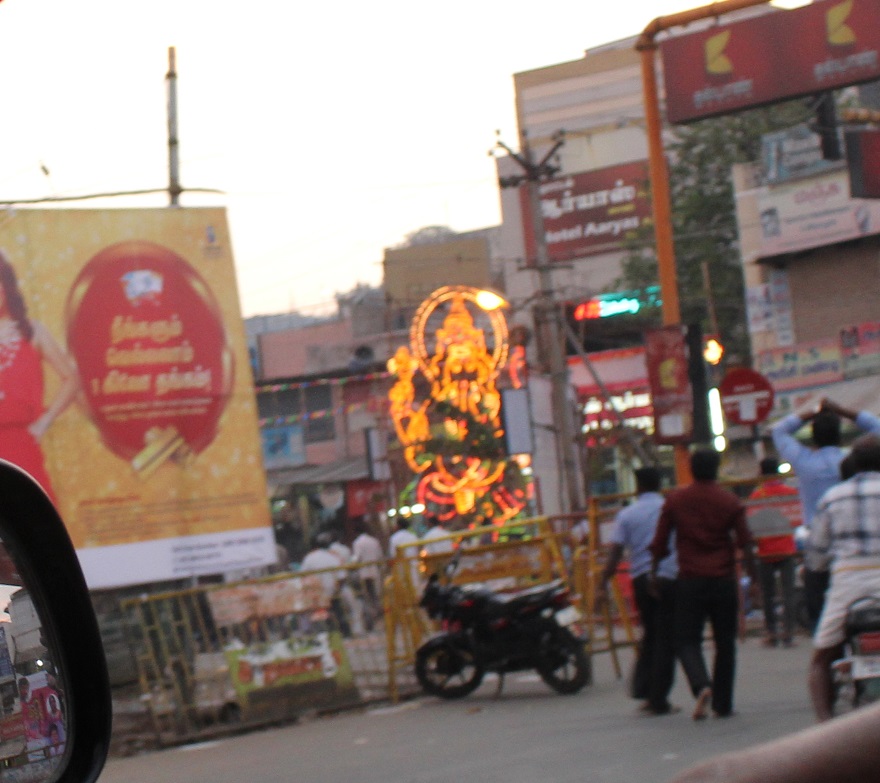
We finally got stopped by a policeman and told that we could drive no further into town. We could not get any closer to the temple as there was a gigantic celebration and that hundreds of thousands of people were coming into town from all over India for it. The policeman pointed to a parking lot and told Darshan that he could park there and we would have to walk up to it. I told Darshan that it was okay and that we could walk, but he felt it would not be safe, this many people, and if he lost me, he would never find me. So we decided not to go to the temple, but that next trip I have to India, that he will bring me back here. So we decided to get something to eat.
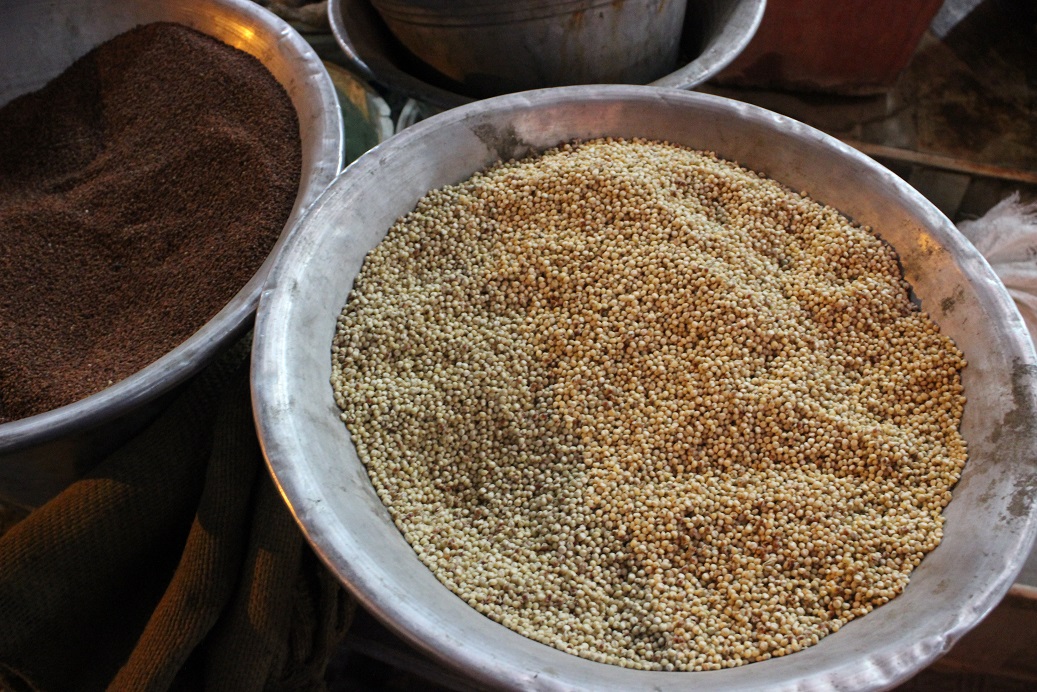
We asked around to find a restaurant. The owner was so happy to see us, even though the restaurant was full, and offered to prepare us a special meal, which by that time I was so hungry I forgot to take a picture! On our way out of the restaurant, we stop by a little shop and admire the spices.

I wish I could have brought some home, but I haven’t figured out how to do that through customs.
For our last leg home, we had to drive a couple of hundred miles. All the nightmare stories about roads in India became very believable that night. Every 100 yards of road would change from paved road to dirt road…for a hundred miles at least! It was very hard. I was really tired, but I knew Darshan was also, so I wanted to stay awake to keep him awake.
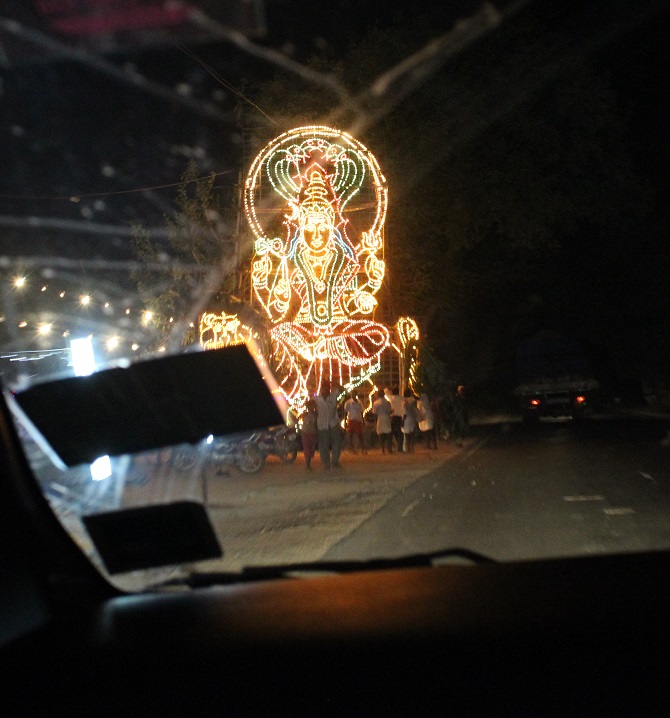
The best part of the drive was going through the small towns that were also celebrating. They made these incredible light-up floats honoring the Gods and Goddesses.
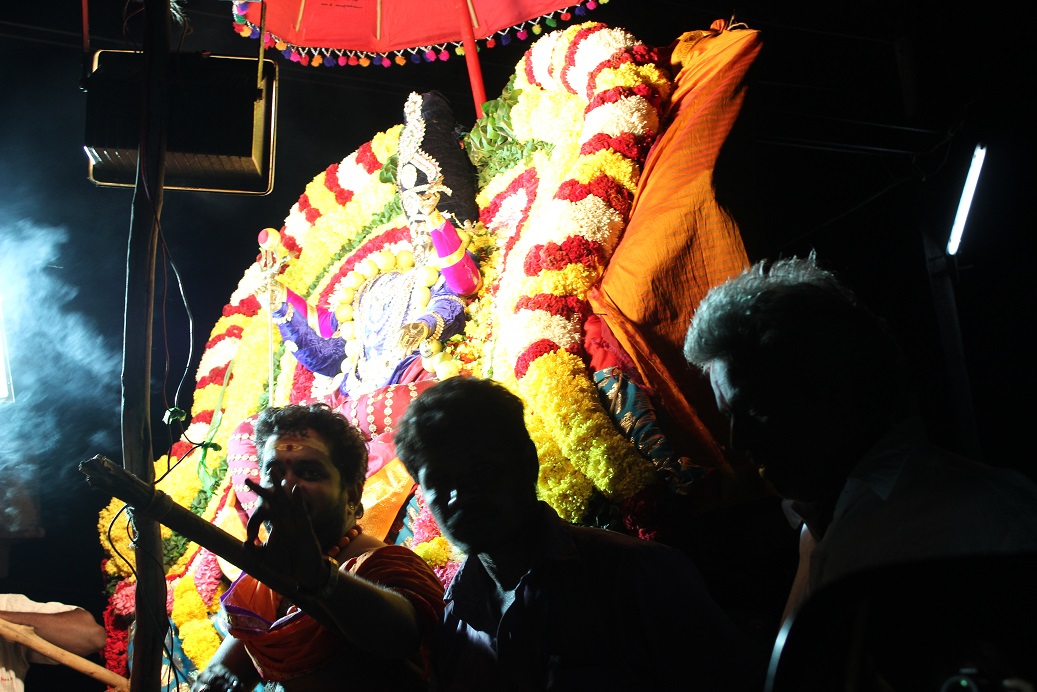
These guys were great. I rolled the window down to take their picture and they came over and put ashes on my head to bless me. It was a perfect ending to such a great trip to Chennai. We drove another four hours and finally made it back to the hotel. I needed to get some sleep as I had appointments at the ashram the next day.
Thanks for reading and sharing with your friends. Thanks again to my sister Jackie for editing this piece, I really appreciate you.
Check me out at www.thebalancedyogi.com for all my blogs and info. I am also now expanding my schedule to offer more private one on one yoga lessons as well as private and corporate classes. You can also schedule an Ayurveda consultation by calling me at 972-658-1600. Let me know if you have an interest.
Blessings,
Peggy
